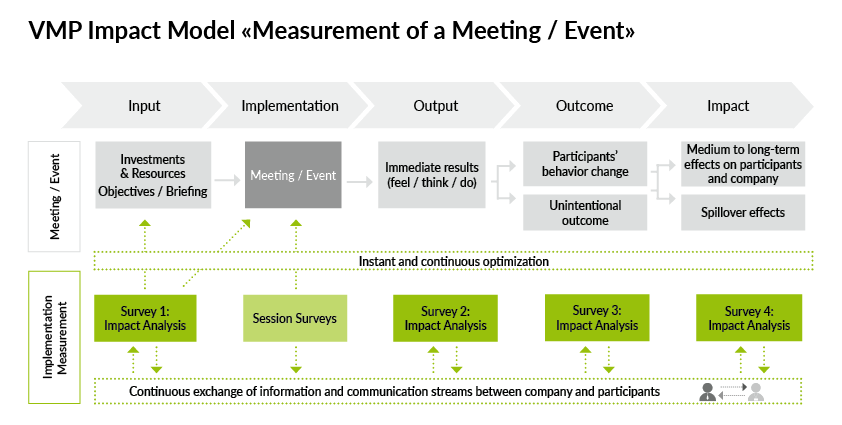Learning drives Event ROI / ROO (5/5)
What exactly is the business value of your event? When both the participants and the meeting host feel highly satisfied while driving home after a business event… can we conclude that the investment in the event was definitely worth it?
No, we can’t. A reliable impact measurement system closely monitors what participants learn at an event, how they plan to change their behavior afterwards and how their behavior actually changes. We need to observe change over time.
Of course, we want our participants to feel excited and content after the event. We know that this will affect learning in a positive way. But participant satisfaction does not necessarily mean that the event creates positive business value (meaning that the value of the event exceeds its cost).
In this blog post, we will bring the importance of learning in the context of events to light. We take a closer look at what learning can entail and what is required for a solid impact measurement of learnings.
From Learning to Business Impact
From the point of view of the meeting owner and the business that invests in the event, meeting success means business impact. What drives such impact in the context of meetings and events?
Learning in a perfect meeting environment (hospitality, speaker quality, etc.) should bring cognitive change, which then leads to changed behavior towards a favourable business outcome. Cognitive change might be conscious or subconscious. However, there must always be a shift in our minds before our behavior can change (see Theory of Planned Behavior by Ajzen).
In business, return on investment ROI and return on objectives ROO are terms that are often used to measure the effectiveness of any project. At VMP we apply the industry-standard ROI Methodology framework. In case we sparked your interest about our method, you will find more details here. But enough with the theory, let’s keep a practical attitude.
Types of Learnings
Almost all event activities can fall under the definition of learning. In summary, there are four different “types” of learning at meetings or events:
- Information learning. There is usually some information learning taking place at every event. For example: a meeting might update employees about the business results of the previous year, they might learn about a new HR strategy or business trends (strategic management meeting), etc.
- Skills learning. Some events focus on helping the participants to acquire new skills. Learning skills is similar to traditional information learning. For example: learning how to use new software, learning a new diagnostic procedure at a medical congress, learning about cancer treatment with a new drug (medical meetings), etc.
- Relationship learning. A goal that is common to nearly all meetings is to get people to know each other. In principle, any form of peer learning at an event benefit from the strength of personal relationships. The relationship might also be between the company and meeting participant: for example, when meeting participants learn to trust and like the company.
- Attitude learning. A meeting might focus, for example, on teaching core company values and attitudes to employees. Attitude learning also refers to the degree to which a participant has a favorable or unfavorable opinion or rating of the objectives of the meeting.
Impact measurement over time
Surveys can closely monitor all types of learning over time, as learning subsequently leads to behavioral change in the long run. The most commonly used tool to measure the effects of learning are participant surveys. It is a straightforward and quick way to measure.
The VMP Measurement Model depicts those surveys along the timeline (green boxes). We usually do three surveys after the event. If you are interested, you will find more details here. Or call us and we’ll talk about it!

Challenges
Any event we measure must have clear, unambiguous and measurable objectives. At the start of every meeting planning process, those objectives must be fixed. We then design the meeting accordingly. If the meeting design and impact measurement are based on different objectives, the measurement results will not be reliable anymore. Clear and unambiguous objectives not only help the meeting planners (planning agency and company) to stay focused and align all aspects of the meeting to the goals, but also make impact measurement possible (for more details, check out the grey box here).
In addition to all the benefits that any event impact measurement system brings to the table, there are certain risks involved as well. Designing a meeting while knowing that the objectives are continuously being measured could feel a bit rigid and too structured. We are always careful that it does not kill our creativity and innovation when planning the meeting.
Conclusion
With any event we always want to create the highest possible value while optimizing cost. As we now understand, “learning” is a driving factor: To create value, the participants have to learn first and do something afterwards, something that creates value to the stakeholders. We as meeting designer are always challenged to make the participants do something they would otherwise not.
Our objective-based methodology is applicable to any project that is bound to change the behavior of people. We therefore can use it for different channels of communication campaigns as well.
“ Tell me and I forget, teach me and I may remember, involve me and I learn. ”
Do you want to implement an impact measurement system at your next event? We can help and coach – contact us today !
_____________________________________________________________________________________________________
More of our series on impact measurement (ROI and ROO) and efficient experience design:
- A Call for Transparency – Total Meeting Costs (1/5)
- Proving Value through Strategic Impact Measurement – ROI & ROO (2/5)
- Target Audience and the Importance of Personas (3/5)
- The Perfect Meeting Envrionment to optimize ROI / ROO (4/5)
- 10. February 2020
- 0 Comments
Comments





